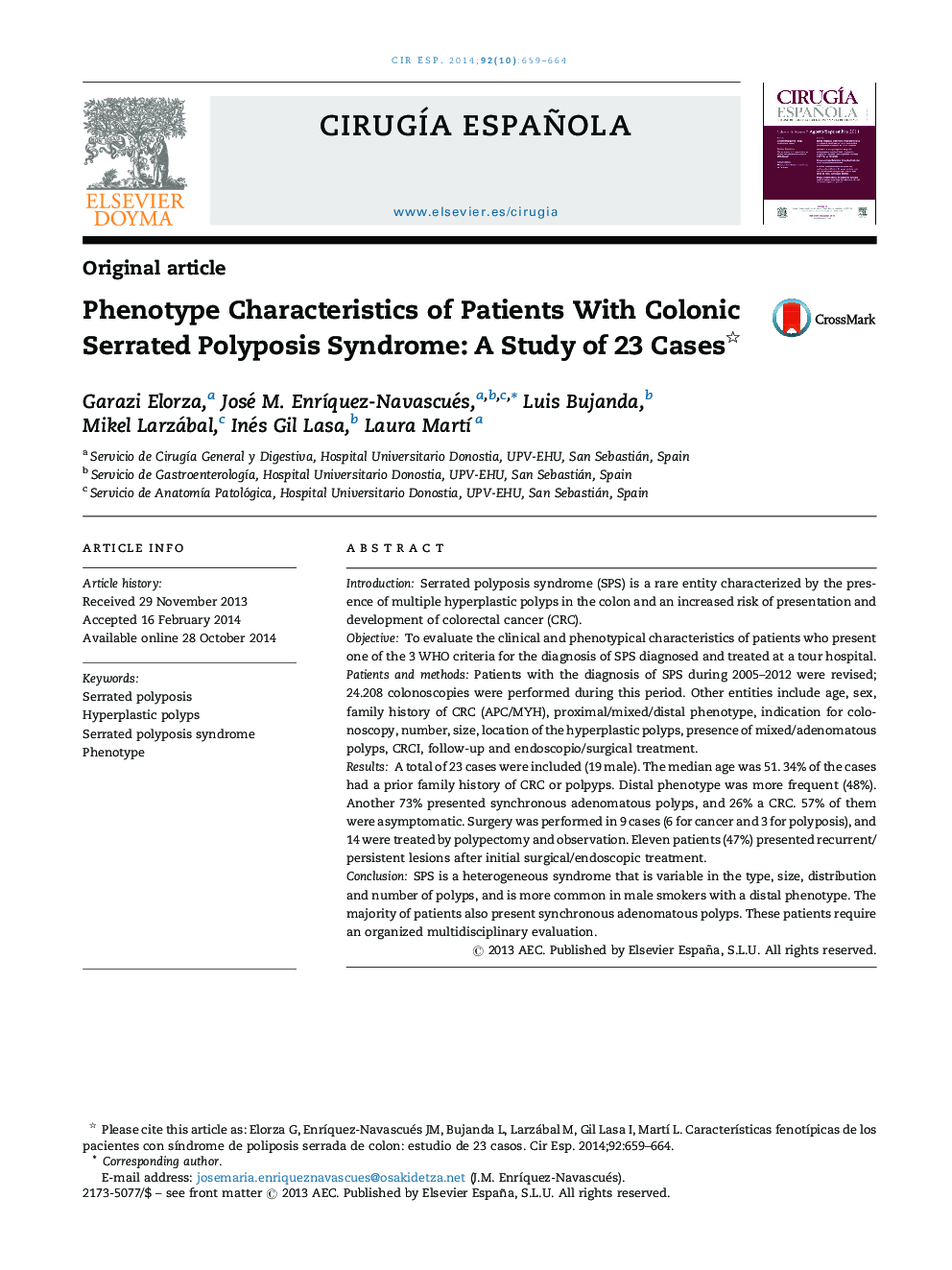| کد مقاله | کد نشریه | سال انتشار | مقاله انگلیسی | نسخه تمام متن |
|---|---|---|---|---|
| 4254933 | 1284413 | 2014 | 6 صفحه PDF | دانلود رایگان |
IntroductionSerrated polyposis syndrome (SPS) is a rare entity characterized by the presence of multiple hyperplastic polyps in the colon and an increased risk of presentation and development of colorectal cancer (CRC).ObjectiveTo evaluate the clinical and phenotypical characteristics of patients who present one of the 3 WHO criteria for the diagnosis of SPS diagnosed and treated at a tour hospital.Patients and methodsPatients with the diagnosis of SPS during 2005–2012 were revised; 24.208 colonoscopies were performed during this period. Other entities include age, sex, family history of CRC (APC/MYH), proximal/mixed/distal phenotype, indication for colonoscopy, number, size, location of the hyperplastic polyps, presence of mixed/adenomatous polyps, CRCI, follow-up and endoscopio/surgical treatment.ResultsA total of 23 cases were included (19 male). The median age was 51. 34% of the cases had a prior family history of CRC or polpyps. Distal phenotype was more frequent (48%). Another 73% presented synchronous adenomatous polyps, and 26% a CRC. 57% of them were asymptomatic. Surgery was performed in 9 cases (6 for cancer and 3 for polyposis), and 14 were treated by polypectomy and observation. Eleven patients (47%) presented recurrent/persistent lesions after initial surgical/endoscopic treatment.ConclusionSPS is a heterogeneous syndrome that is variable in the type, size, distribution and number of polyps, and is more common in male smokers with a distal phenotype. The majority of patients also present synchronous adenomatous polyps. These patients require an organized multidisciplinary evaluation.
ResumenIntroducciónEl síndrome de poliposis serrada (SPS) es una entidad rara caracterizada por la presencia de múltiples pólipos de histología hiperplásica en el colon y un riesgo aumentado de presentar y desarrollar cáncer colorrectal (CCR).ObjetivoEvaluar las características clínicas y fenotípicas de los sujetos que reúnen alguno de los 3 criterios de la OMS para el diagnóstico de SPS, diagnosticados y seguidos en nuestro hospital.Pacientes y métodosSe revisan los pacientes con SPS durante 2005-2012, periodo en el que se realizan 24.208 colonoscopias. Se analizan edad, sexo, historia familiar de CCR (APC/MYH), fenotipo proximal/mixto/distal, indicación de colonoscopia, número, tamaño, localización de los pólipos hiperplásicos, presencia de pólipos mixtos/adenomatosos, CCRI, seguimiento y tratamiento endoscópico/quirúrgico.ResultadosSe han recogido 23 casos (19 hombres). El promedio de edad fue 51 años. El 34% presentaba antecedentes familiares de CCR o pólipos. El fenotipo distal (48%) fue más frecuente. El 73% presentaba pólipos adenomatosos sincrónicamente, y el 26% un CCR. El 57% eran pacientes asintomáticos. Se realizó cirugía en 9 casos (6 por cáncer y 3 por poliposis, y 14 con polipectomías sucesivas y observación). Un total de 11 pacientes (47%) presentaron lesiones recurrentes/persistentes tras el tratamiento quirúrgico/endoscópico inicial.ConclusiónEl SPS es un síndrome heterogéneo, variable en tipo, tamaño, distribución y número de pólipos, siendo más frecuente en varones fumadores con fenotipo distal. La mayoría de los pacientes presentan además pólipos adenomatosos de manera sincrónica. Estos pacientes requieren una evaluación organizada multidisciplinar.
Journal: Cirugía Española (English Edition) - Volume 92, Issue 10, December 2014, Pages 659–664
